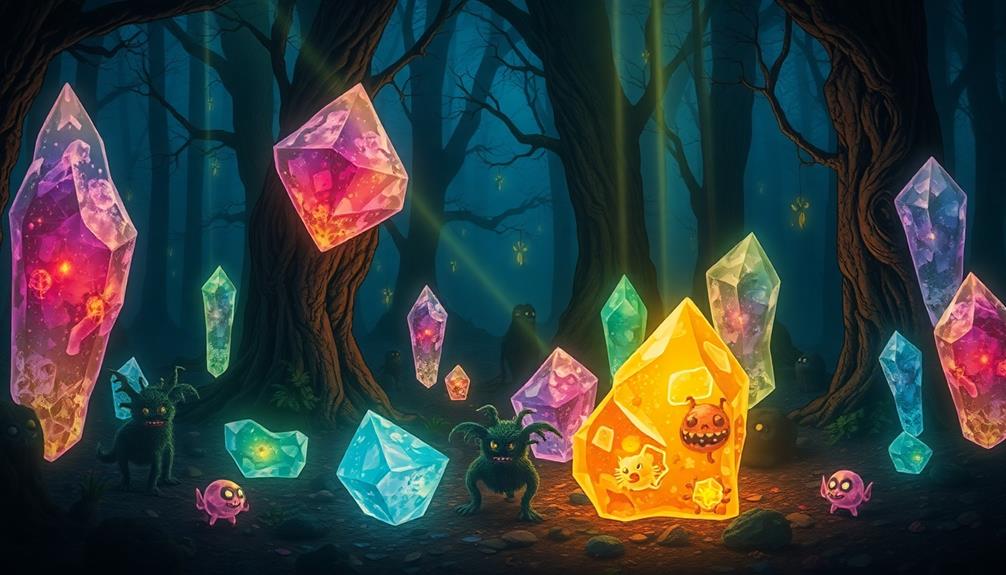Demonic contracts with sea serpents are powerful symbols in maritime folklore, representing dangerous yet mystical pacts sailors believed could grant control over the sea’s fury or reveal hidden truths. These legends often involve vows made to mysterious creatures, blending fear, reverence, and hope. Such stories serve as warnings or rites of passage, deeply rooted in cultural beliefs about the divine and the unknown. If you stay curious, you’ll discover how these legends shaped seafaring traditions and modern tales alike.
Key Takeaways
- Maritime legends depict sea serpents as powerful beings with whom sailors made pacts to ensure safe passage or control over storms.
- These contracts symbolize a transfer of power, often involving offerings or mystical rituals to appease or gain favor from the sea creature.
- Sea serpent pacts serve as allegories for dangerous bargains, representing human fears, forbidden knowledge, and the peril of secretive oceanic deals.
- Historical and mythological stories link sightings of sea serpents to superstitions, ghost ships, and mysterious shipwrecks, reinforcing the idea of spiritual contracts.
- Modern interpretations view these maritime pacts as symbolic narratives reflecting moral dilemmas, ambitions, and the mystical reverence for the ocean’s unknown forces.
Origins of Maritime Legends Involving Sea Serpents and Demonic Bargains
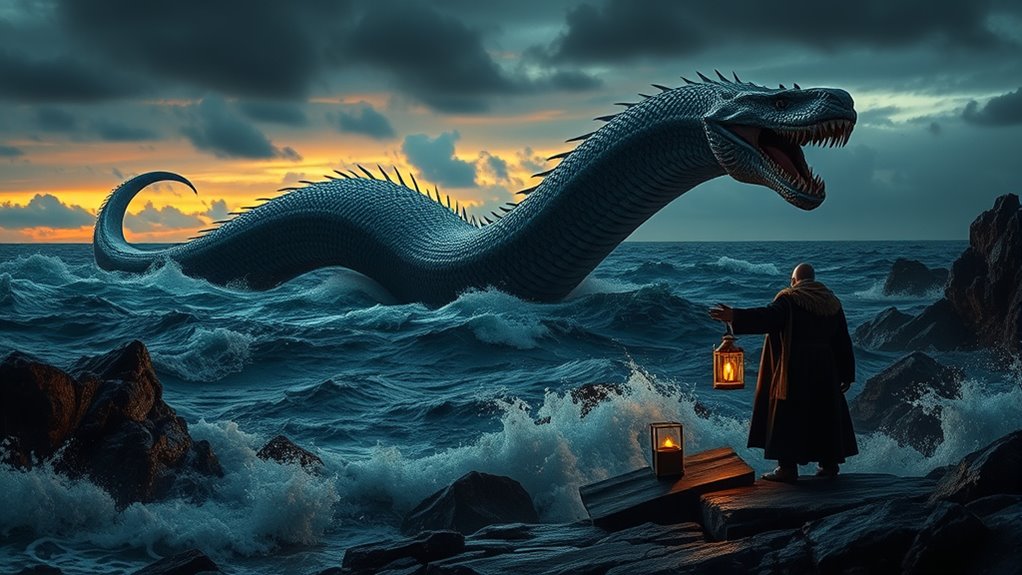
Many maritime legends about sea serpents and demonic bargains originate from sailors’ encounters with the unknown and their attempts to explain strange phenomena at sea. These stories often draw from ancient symbolism, where creatures like sea serpents represent chaos, danger, or divine forces. Sailors used mythical allegories to interpret their experiences, transforming unexplained sightings into powerful symbols of nature’s mystery. These legends served to personify natural phenomena—stormy waters, whirlpools, or mysterious lights—by linking them to mythical beings or demonic pacts. Over time, such stories reinforced cultural beliefs about the sea’s spiritual significance, blending folklore with symbolism. These tales became a way for sailors to make sense of their perilous voyages, embedding mythic allegories into maritime tradition.
Symbolism and Meaning Behind Sea Serpent Pacts in Folklore
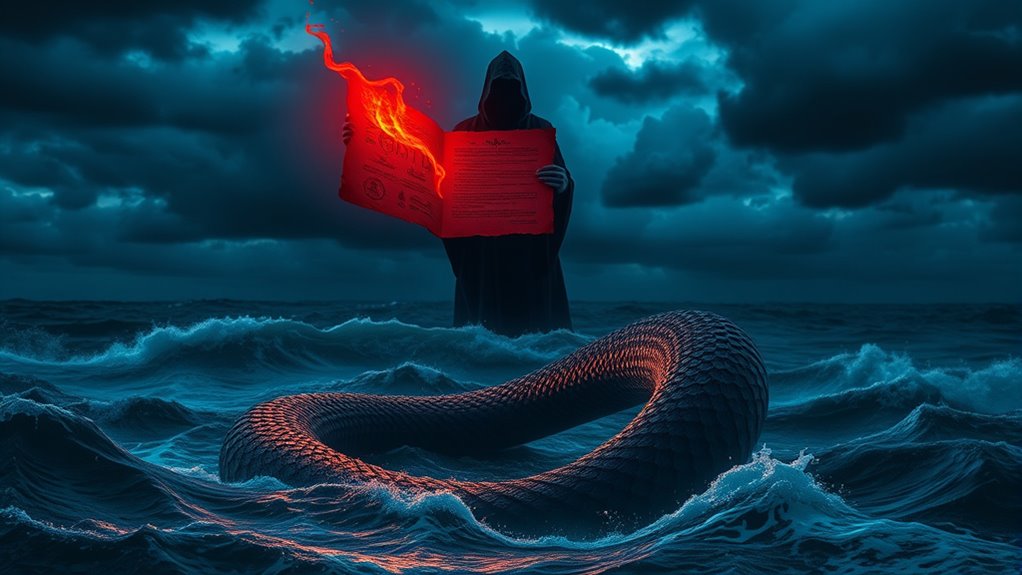
Sea serpent pacts often symbolize power and dominance over nature, reminding you of the creature’s control. They also evoke fear and respect, illustrating the dangerous allure of forbidden knowledge. These agreements reflect a desire to harness supernatural forces, often at great personal risk.
Power and Dominion
In folklore, sea serpent pacts often symbolize a transfer of power, where forming an agreement with these mythic creatures grants you access to their formidable strength and domain. Such pacts represent a shift of authority, often tied to oceanic bargains that deepen your influence over the sea. These alliances can grant control over storms, navigation, or hidden depths, amplifying your dominion. The symbolism highlights a desire to harness the serpent’s raw power, often at a cost. The table below explores different facets of this power:
| Aspect | Symbolic Meaning | Practical Impact |
|---|---|---|
| Mermaid alliances | Trust and seduction | Enhanced influence over sea creatures |
| Oceanic bargains | Control over the waters | Increased navigation and protection |
| Sea serpent pact | Raw destructive force | Domination of maritime domains |
Fear and Respect
Forming a pact with a sea serpent often signifies a balance between fear and respect, reflecting the creature’s immense power and the danger it embodies. In folklore, ancient rituals are performed to honor the sea serpent’s mystique, emphasizing its role as a formidable force of nature. These rituals often involve mystical symbols—such as carved talismans or ritualistic markings—that serve to communicate reverence and establish boundaries. Such symbols remind you of the serpent’s dual nature: awe-inspiring yet deadly. The act of forging these pacts underscores a recognition that respect is necessary to survive encounters with these creatures. Fear keeps you cautious, while respect acknowledges their dominance over the sea’s unpredictable depths. Together, these elements cultivate a complex relationship rooted in both admiration and wariness.
Forbidden Knowledge
The pacts with sea serpents are rich with symbolic meaning, serving as more than mere agreements—they represent the transfer and concealment of forbidden knowledge. These mythical alliances often uncover deep sea mysteries, hinting at secrets hidden beneath the waves. Such pacts symbolize humanity’s desire to access hidden truths about the ocean’s depths, but also warn of dangerous consequences. You might see these agreements as a metaphor for delving into the unknown, risking everything for forbidden insight. The sea serpent becomes a guardian of mystical secrets, embodying the peril and power of forbidden knowledge. These symbols highlight the dangerous allure of exploring mysteries that should remain concealed, emphasizing the high stakes involved in seeking beyond human understanding.
- Secrets of the deep sea
- Hidden truths of the ocean
- Power over mysterious forces
- Transcending mortal limits
- The peril of forbidden insight
Famous Maritime Tales and Encounters With Sea Serpents
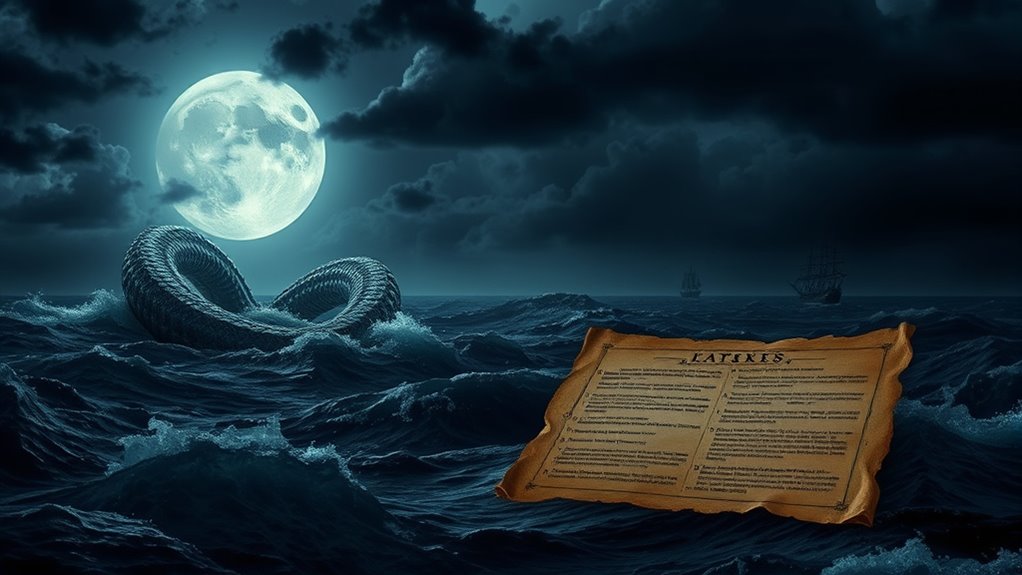
Throughout history, sailors have reported incredible sightings of massive sea monsters that seem almost too fantastical to be true. These encounters often come with stories of superstitions and strange deals made in hopes of avoiding disaster. Exploring these legendary tales reveals how such events shaped maritime folklore and sailors’ beliefs.
Legendary Sea Monster Sightings
Have you ever wondered if those mysterious sightings of enormous sea creatures during maritime voyages were real? Many legendary encounters with sea monsters remain part of maritime folklore, fueling curiosity about oceanic phenomena and shipwreck mysteries. These tales often describe massive, serpentine shapes surfacing unexpectedly, sparking fears and legends. Sometimes, sailors report seeing giant fins or twisting bodies that vanish as suddenly as they appeared. Such sightings could be influenced by optical illusions or unusual oceanic phenomena, but they’ve persisted through centuries. These stories serve as cautionary tales, blending reality and myth. Whether based on real encounters or exaggerated memories, these sightings continue to captivate maritime lore and inspire speculation about what lurks beneath the waves.
- Unexplained sonar signals and visual reports
- Historical records of massive sea creature sightings
- Correlation with shipwreck mysteries
- Effects of oceanic phenomena on perception
- Cultural influences shaping these legends
Mariners’ Superstitions and Deals
Mariners have long believed that encounters with sea serpents and other mythical creatures carry powerful superstitions and stakes, often influencing their decisions at sea. When a sailor spots a sea serpent near a treasure chest or a ghost ship, it’s seen as a sign of impending danger or a cursed voyage. Many believe that making deals with these creatures can bring luck or doom, depending on the pact. Stories tell of sailors who traded their souls or promised offerings to avoid the serpent’s wrath, only to face haunted ships or lost treasures. These superstitions serve as warnings—trusting the sea’s mysterious creatures can lead to both riches and ruin, reinforcing the idea that the ocean’s depths hide more than just monsters.
The Role of Supernatural Entities in Seafaring Mythology
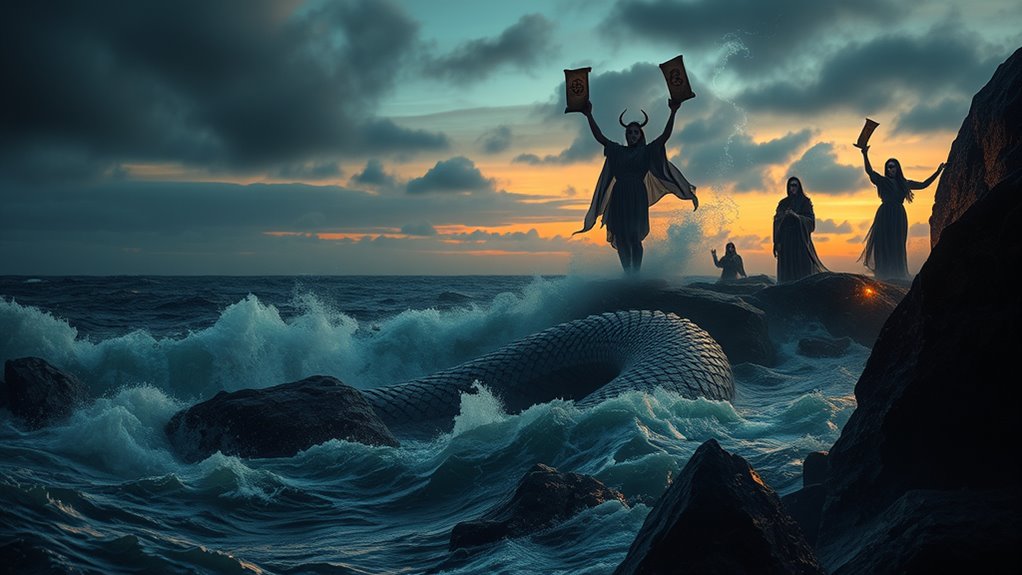
Supernatural entities have long played a pivotal role in seafaring mythology, serving as both warnings and protectors for those who venture into the unknown waters. These beings embody underwater symbology and mythic archetypes that shape sailors’ perceptions of the ocean’s mysteries. They often symbolize nature’s power, unpredictability, and spiritual significance. You might encounter sea monsters as cautionary figures, representing chaos, or benevolent spirits guiding sailors safely home. Such entities reinforce the idea that the ocean is a domain of both danger and divine influence. Their presence in stories and rituals highlights humanity’s attempt to understand and appease the supernatural forces lurking beneath the waves.
- Underwater symbology as a reflection of unseen danger
- Mythic archetypes embodying oceanic power
- Spirits as guardians or punishers
- Symbolism of sea monsters as chaos incarnate
- Rituals to appease supernatural sea beings
Influence of Sea Serpent Contracts on Maritime Culture and Literature

Throughout maritime history, stories of sea serpent contracts have shaped the way sailors and writers interpret their encounters with these legendary creatures. These tales often originate from ancient navigational myths, where sea serpents symbolize both danger and divine oversight. Such stories influence maritime ritual symbolism, as sailors performed rituals to appease or seek favor from these beings, believing contracts could guarantee safe passage. Literature reflects this cultural impact, depicting sea serpents as powerful entities bound by pact-like agreements with sailors or deities. These narratives reinforce the idea that human encounters with the sea are governed by spiritual agreements, blending fear, reverence, and hope. Overall, sea serpent contracts leave a lasting mark on maritime culture, shaping beliefs, rituals, and storytelling traditions across generations.
Modern Interpretations and Legacy of Maritime Demonic Pacts
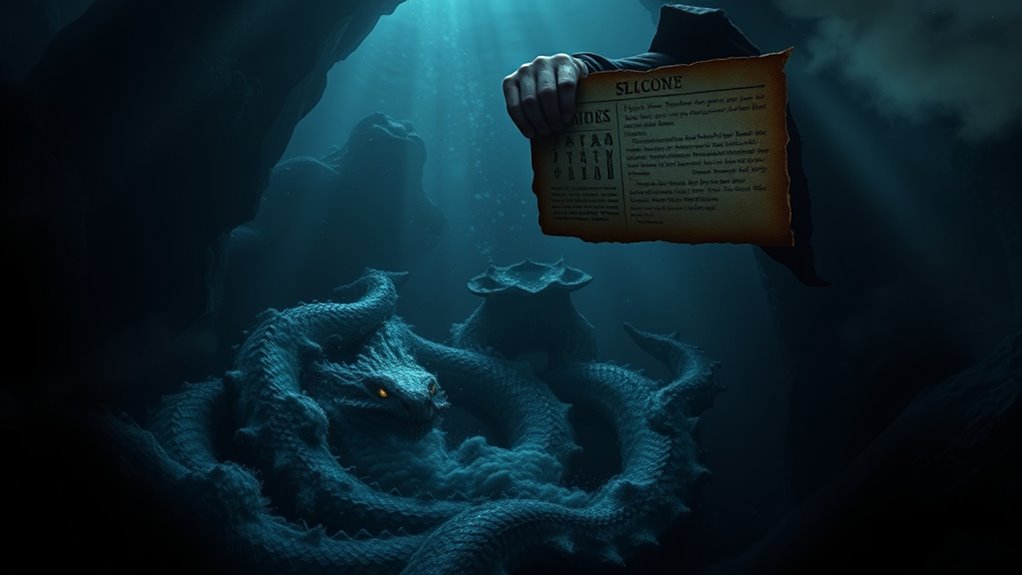
Modern interpretations of maritime demonic pacts often explore their symbolic meanings beyond historical accounts, blending folklore with psychological and cultural insights. You may see these pacts as representations of human fears, ambition, or moral dilemmas, rather than literal agreements. In contemporary discourse, modern symbolism emphasizes their role as metaphors for risky pursuits or moral compromises at sea. Maritime legalities also influence these interpretations, highlighting how maritime law historically addressed contracts with supernatural elements—sometimes treating them as allegories for real legal disputes. These ideas persist in popular culture, shaping stories of sailors and sea monsters.
- Symbolic reflection of human psyche
- Allegories for moral choices
- Reflection of maritime legalities
- Cultural identity markers
- Influence on modern storytelling
Frequently Asked Questions
Are There Documented Historical Cases of Real Demonic Sea Serpent Contracts?
You might wonder if there’s historical evidence of real demonic sea serpent contracts. While folklore verification shows many legends of maritime pacts, no credible historical records confirm such demonic agreements actually occurred. Most stories stem from sailors’ superstitions and myth-making rather than documented events. So, despite intriguing tales, you won’t find verified cases of authentic demonic sea serpent contracts in history.
How Have Different Cultures Depicted Sea Serpent Pacts Uniquely?
Think of the sea as a mirror reflecting cultural myths, each culture painting its own picture of sea serpent pacts. In Norse legends, they symbolize chaos and power; in Chinese folklore, they embody divine wisdom and control over water. These cultural variations reveal how myths serve as vessels for mythical symbolism, shaping stories of alliances with sea monsters that resonate with each society’s values and fears, creating a rich tapestry of maritime folklore.
What Rituals or Symbols Are Associated With Forging These Maritime Contracts?
You might perform ritual ceremonies involving sacred symbols to forge maritime contracts with sea serpents. These rituals often include offerings like shells or ancient artifacts, accompanied by chants or prayers to invoke the sea spirit’s favor. Symbols such as intertwined knots or spirals represent the binding nature of the pact. By engaging in these sacred rituals, you seek to establish a powerful, mystical connection that governs your relationship with the sea and its legendary guardians.
Do Modern Maritime Artists or Writers Incorporate These Legends Today?
You’ll find that modern maritime artists and writers often incorporate maritime symbolism and folklore adaptations into their work. They draw inspiration from legendary sea creatures and maritime pacts, blending traditional stories with contemporary themes. This creates a rich tapestry of mythology that resonates with current audiences. By weaving folklore into their art and stories, they keep maritime legends alive, fostering a deeper appreciation for seafaring history and its mysterious, mythical elements.
Are There Any Scientific Explanations for Sea Serpent Sightings Linked to These Pacts?
Like explorers chasing legends, you wonder if cryptid sightings, like sea serpents, have scientific roots. Marine biology suggests these sightings often stem from misidentified marine animals, such as oarfish or giant squids, or optical illusions. While folklore hints at pacts and demons, science finds natural explanations. So, your curiosity aligns with ongoing efforts to understand these mysterious creatures, blending myth with marine science.
Conclusion
As you navigate these legends, it’s like sailing through a stormy sea of shadows and whispers, where sea serpents are the dark, twisting roots of human fears and desires. These demonic contracts are the tangled nets sailors once cast, binding them to unseen forces lurking beneath the waves. Their stories remind you that, just like the ocean’s depths, some mysteries are best left undisturbed—yet they continue to ripple through our collective imagination, forever echoing in the tides of folklore.






